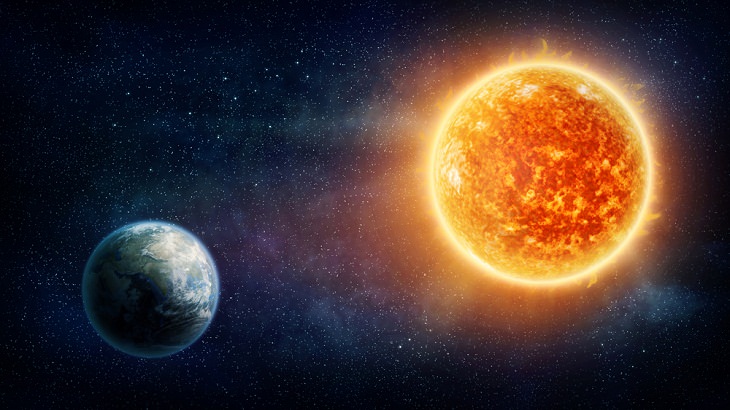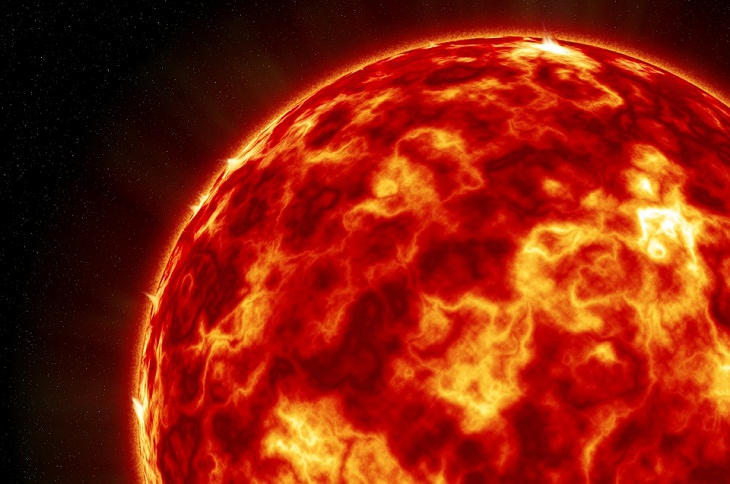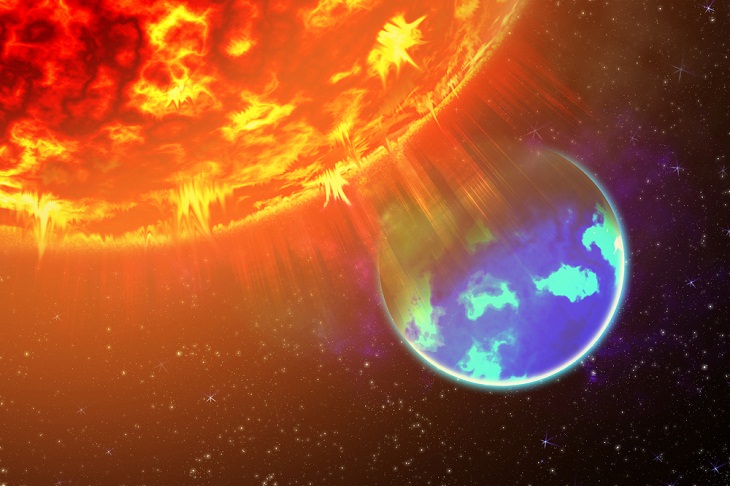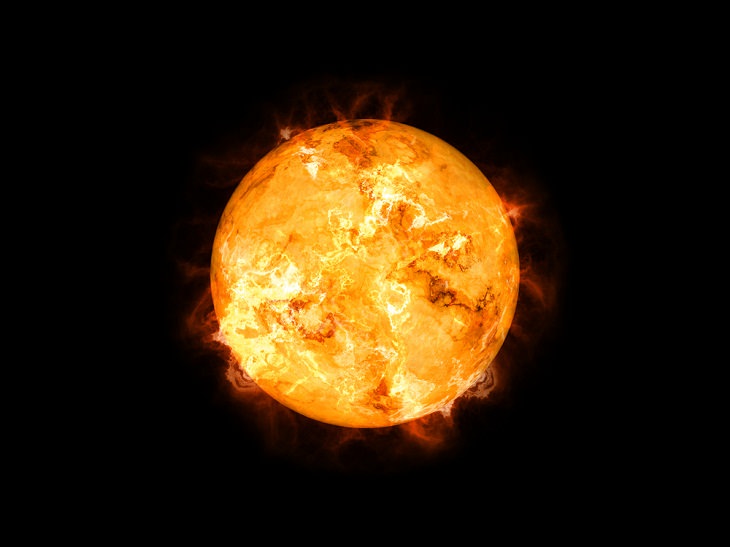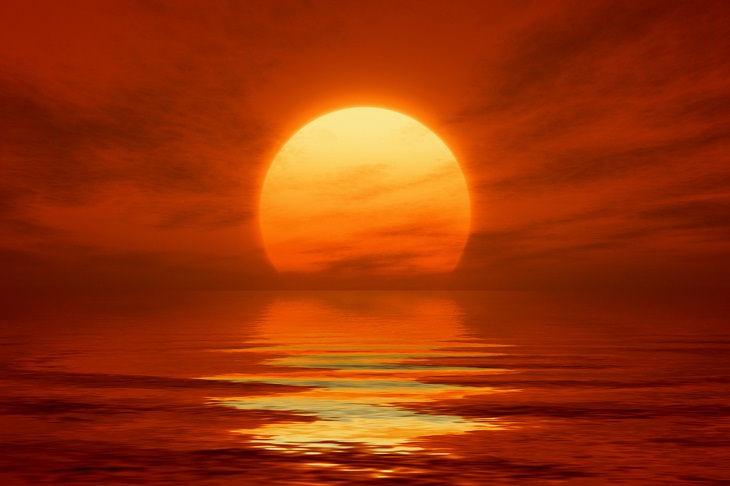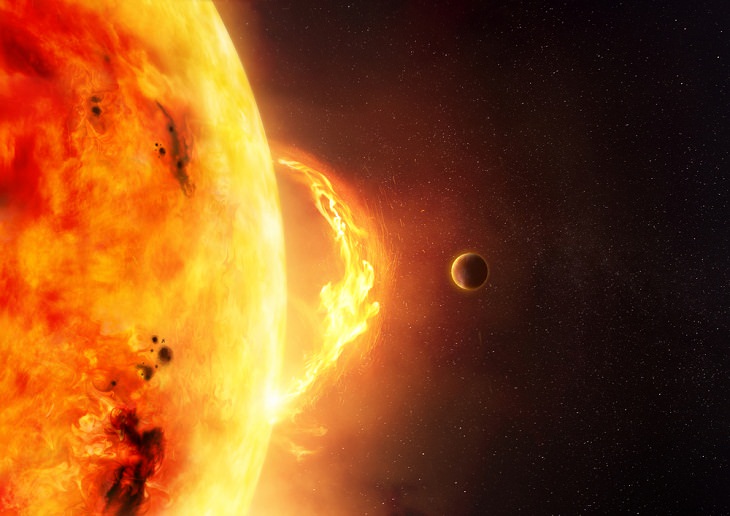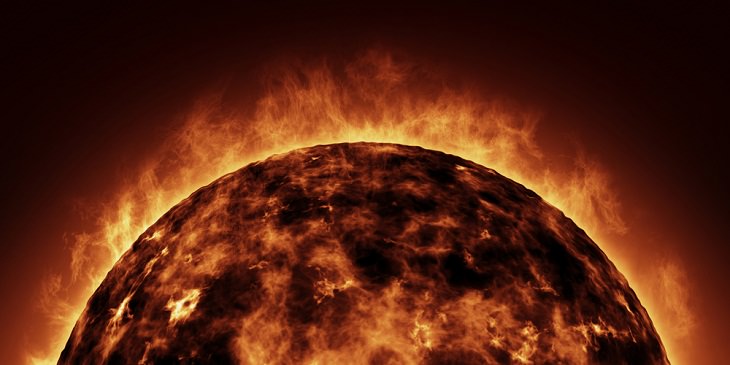1. One million Earths could fit inside the Sun
The Sun’s surface area is 11,990 times that of the Earth. Thus, if the Sun was hollow, it could be filled up with approximately 960,000 spherical Earths inside it. In fact, if we wanted to really squish those Earths inside a hollow Sun, leaving absolutely no space for anything else, then we could make space for around 1,300,000 of them!
2. The Sun makes up 99.85% of the mass of the Solar System
The Sun is easily the largest object in the Solar System. It makes up more than 99.8% of the total mass of the Solar System (while Jupiter comprises most of the rest). The Sun’s mass is almost 330,000 times greater than that of Earth. It consists of approximately three-quarters of Hydrogen while the remaining part is taken up by Helium. Interestingly, this changes over time as the Sun converts Hydrogen to Helium in its core.
3. The Sun’s temperature is about 15 million degrees Celsius
We all know that the Sun is hot. But have you ever wondered exactly how hot it is? The temperature inside the Sun can reach 15 million degrees Celsius (about 27 million degrees Fahrenheit). At the Sun’s core, gravity creates fierce pressure and leads to an incredible increase in temperatures. This, in effect, produces nuclear fusion responsible for the star's energy.
Also, the temperature on the surface of the Sun is about 5,600 degrees Celsius (10,112 degrees Fahrenheit). The Sun produces energy at its core through nuclear fusion, as Hydrogen converts to Helium. If it were not for its massive gravitational force, the Sun would actually explode.
4. Light from the Sun takes eight minutes to reach Earth
The Sun is at an average distance of 150 million kilometers (93 million miles) from the Earth. Now, light travels at the speed of 300,000 kilometers per second. If we divide one by the other, it gives us an approximate time of 500 seconds (or eight minutes and 20 seconds). So basically, if the Sun would suddenly disappear from the Universe, it would take us a little more than 8 minutes to realize it. While this may seem quite quick, you would be surprised to know that this energy would have taken millions of years to travel from the Sun’s core to its surface.
5. The Sun has a remarkably powerful magnetic field
It is because of its incredibly strong magnetic field that the Sun produces many magnetic storms. The Sun releases magnetic energy during these magnetic storms which, in turn, cause solar flares. For us, these solar flares appear as sunspots which you would have seen in many close-up photos of the Sun. These sunspots are basically dark spots on this yellow dwarf star’s surface. In these sunspots, the magnetic lines in the storms are twisted and they spin. This is very similar to a tornado on Earth.
6. The Sun may consume the Earth eventually
The Sun is slowly expanding and brightening. Scientists say that over the next few billion years it will eventually evaporate the Earth and leave it completely dry. In fact, within just a billion years, the heat from the Sun will become so severe that liquid water won’t exist on the surface of the Earth. Thus, all life on Earth will be extinguished (except maybe for bacteria living underground).
What will be left is a hot, brown, and uninhabitable planet Earth. It is estimated that about 7.6 billion years from now, the Sun will achieve its maximum size as a red giant. It would have exhausted all its Hydrogen but will continue to burn Helium for another 130 million years. It will keep expanding until it has engulfed Mercury, Venus, and the Earth.
During that time, the Sun’s surface is expected to extend beyond Earth’s orbit today by 20 percent and is likely to shine about 3,000 times brighter.
7. The Sun generates solar wind
The Sun sometimes generates something called solar winds. They are a steady stream of charged particles like protons and electrons that travel through the Solar System at roughly 450 kilometers (280 miles) per second. These solar winds are created when the magnetic field of the Sun extends into space. They can stream all the way to planetary surfaces unless they are blocked by an atmosphere or a magnetic field. Since Earth has a strong magnetic field, it tends to deflect most of the charged particles that make up solar winds as they get close to the planet.
8. The Sun is middle-aged
While the Sun has been around for ages, it isn’t exactly too old either. According to astronomers, the Sun, along with many other planets, was formed from the solar nebula about 4.59 billion years ago. At present, the Sun is in the main sequence stage and is slowly rising up its hydrogen fuel. It is predicted that at some point in the future, about 5 billion years from now, the Sun will enter the red giant phase which we’ve explained above. The Sun is currently a type of star known as a Yellow Dwarf.
9. The Sun is made up of many layers
Even though it looks as if the Sun is just a burning ball of fire, it actually has an intricate internal structure. What we see is the visible part of the sun which is known as the photosphere that heats up to a temperature of about 6,000 degrees Kelvin. Below that lies the convective zone. Heat moves slowly from the inner Sun to the surface here and cooled material falls back down in columns.
Underneath the convection zone is the radiative zone. In this region, heat can only travel through radiation. Meanwhile, the core of the Sun stretches from the center of the Sun to a distance of 0.2 solar radii. Here, temperatures reach 13.6 million degrees Kelvin, and molecules of hydrogen are merged into helium.
10. Different parts of the Sun rotate at different speeds
The Sun, unlike other planets, is a giant sphere of hydrogen gas. Different parts of the Sun rotate at different speeds as a result of this. We can gauge how fast the surface is rotating by monitoring the movement of sunspots throughout its surface. At the equator regions, it takes 25 days to complete one rotation. Meanwhile, features at the poles take almost 36 days for the same. The inside of the Sun takes about 27 days for one rotation.
Liked this post? Please share it with others...

